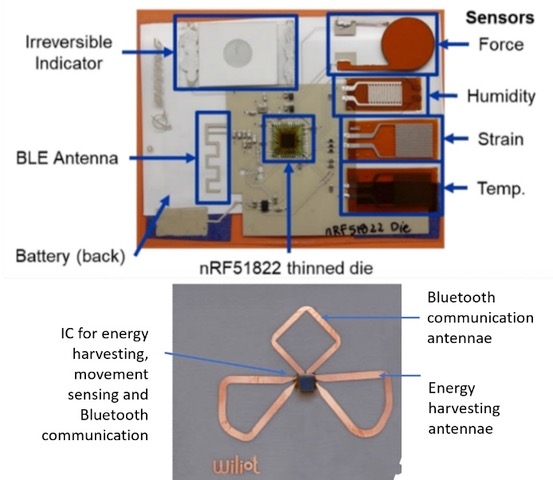While flexible electronics have been around for years, either as flexible PCBs or genuinely printed electronics, there has always been a trade-off between flexibility and capability.
Circuits with a few printed transistors based on organic semiconductors could be printed onto flexible substrates but were not generally capable of significant data processing. On the other hand, thanks to adherence with Moore’s law, very capable silicon ICs (integrated circuits) are incredibly cheap on a per transistor basis but impose a rigid form factor and require careful placement onto a substrate.

A prototypical flexible hybrid electronics circuit (left), which must, as a minimum, include conductive interconnects printed onto a flexible substrate along with a placed integrated circuit. Additional functionality may include thin-film photovoltaics (PV), a thin film battery and printed sensors. Schematic (right) showing how FHE breaks the existing compromise between processing capability and flexibility. To learn more please refer to IDTechEx’s report “Flexible Hybrid Electronics 2020-2030: Applications, Challenges, Innovations and Forecasts.”
Flexible hybrid electronics (FHE) ends this compromise (see schematic). It promises to combine the extensive processing capability of integrated circuits with a flexible form factor, and with printed rather than etched conductive interconnects. This combination of attributes opens a wide range of application possibilities, across many different industries. Indeed, the new IDTechEx report finds that this could be a $3 billion market by 2030.
Ubiquitous Electronics
The global market research firm, IDTechEx, believe that FHE provides a compelling technological approach towards the vision of ubiquitous electronics. The combination of flexibility, processing/communication capability and ultimately compatibility with low-cost, high volume continuous manufacturing methods is unique to FHE but highly applicable to many different sectors. Their new FHE report identifies five main application sectors: smart packaging, wearable/healthcare monitoring, consumer electronics, industrial/environmental monitoring, and automotive/aeronautical. For each application sector, IDTechEx's Analysts evaluate a range of prototypes from different manufacturers/research centers, and each application subsector outline the required circuit attributes, technologies and their technological readiness level. This insight is then employed in constructing detailed market forecasts, by both volumes and revenues, for each application sub-sector.
RFID Sensors
Perhaps the most compelling opportunity for FHE is ubiquitous, low cost wirelessly enabled RFID sensors. These could be employed in industrial and environmental monitoring, and smart packaging. Such capability is a prerequisite for the vision of connected devices and the ‘Internet of Things’, in which data from an increasingly wide range of items is transmitted to the cloud before applying machine learning. At present, passive RFID tags are produced by the billion. Indeed, IDTechEx has been analyzing the RFID market research since the early 2000s and estimate around 18 billion RFID tags will be produced in 2020 (see the IDTechEx report titled “RFID Forecasts, Players and Opportunities 2019-2029” for a complete analysis of the global RFID industry).
Passive RFID tags are only capable of communicating with a reader when specifically addressed. Furthermore, as the name suggests, their only function is identification. FHE would enable ‘RFID sensors’ that can monitor other attributes such as temperature, humidity, stress and strain at specified intervals, and then transmit that information either to a reader or via wireless networks.
The picture below shows a prototype multimodal sensor from Boeing, which could be applied to industrial equipment large and small and would transmit information via Bluetooth to help predict equipment failure and thus improve productivity. Also shown is a prototype sensor from Wiliot, which has Bluetooth capability but does not include a thin-film battery, instead of harvesting electromagnetic energy from its surroundings. A battery-less approach seems a promising route to ubiquitous RFID sensors, since thin-film batteries have limited capacity and will increase device size, cost and manufacturing complexity.

A prototype multimodal sensor incorporating a thin-film battery (top, from Boeing, taken from Flex 2020 Conference in San Jose, CA), and a simpler battery-free sensor on a paper substrate (bottom, from Wiliot). To learn more please refer to IDTechEx’s new report titled “Flexible Hybrid Electronics 2020-2030 Applications, Challenges, Innovations and Forecasts.”
Innovative Thinned ICs
Such a vision will need such RFID sensors to be manufactured in very large volumes with a low cost per unit. This requires R2R (roll-to-roll manufacturing), which is currently employed for passive RFID tags. Adapting this method to FHE introduces some considerable challenges since FHE circuits require a thinned die, and likely other passive components, to be mounted onto a flexible substrate.
Relative to basic RFID ICs that have very limited functionality, thinned FHE ICs (for example a module with ADC and UHF RFID measuring 2.2 mm by 2.3 mm by 25 um) have a much higher aspect ratio and more I/O pads, increasing both fragility and registration requirements during placement. Differential thermal expansion coefficients between polymeric substrates and silicon ICs pose additional challenges for robust attachment, particularly if the circuit is going to be exposed to a wide range of temperatures, such as in automotive applications.
Given this challenge, the production, handling and attachment of thinned dies are very much an innovation area. To learn more about the status, challenges, and innovations in R2R and/or pick-and-place of flexible ICs in flexible hybrid electronics, please see IDTechEx’s new report “Flexible Hybrid Electronics 2020-2030: Applications, Challenges, Innovations and Forecasts”. IDTechExforecast that RFID sensors will start becoming widely adopted in 2025, with over 5 billion units sold per year by 2030.
From PI to PET
Of course, the widespread adoption of RFID sensors requires them to be as cheap as possible. This precludes the use of expensive PI (polyimide) substrates, which will likely be replaced with PET (and even paper for smart packaging applications).
This transition in substrate materials imposes challenges, in that conventional lead-free (SnAgCu) solder can no longer be used. The development of component attachment methods that are compatible with thermally fragile substrates is an area of innovation, including both low-temperature solder, novel anisotropic conductive adhesives, and photo-sintered solder.
To learn more about the merits, status, performance characteristics and limitations, cost, roadmap, and innovators and suppliers of these low-temperature attachment technologies, please see the new IDTechEx report: “Flexible Hybrid Electronics 2020-2030 Applications, Challenges, Innovations and Forecasts”.
An Opportunity for Conductive Ink
Conductive ink, required for the printed interconnects in an FHE circuit, provides another opportunity for cost reductions. Currently, most conductive ink is silver-based, but are intrinsically expensive due to the price of silver metal (around 400 $/kg). Copper-based inks are potentially much cheaper but have long suffered from unwanted oxidation that reduces conductivity. Developing stable copper inks with at least equivalent conductivity to silver inks, while reducing the curing times and temperatures to facilitate rapid manufacturing with thermally fragile substrates is thus a substantial area of innovation. All these innovation trends are discussed extensively in the recently updated IDTechEx report titled “Conductive Ink Markets 2020-2030: Forecasts, Technologies, Players”.
An elegant compromise
In summary, FHE is a new approach to electronic circuits that bridges the gap between printed and conventional electronics, by combining flexibility with processing capability, along with the potential for both agile and continuous manufacturing methods. This combination of attributes is ideally suited to applications including smart packaging, wearable devices and industrial/environmental monitoring. Challenges, and hence innovation areas, are transitioning to cheaper thermally fragile substrates and hence low-temperature attachment methods, lowering the conductive ink, and making FHE circuit production compatible with R2R manufacturing.













